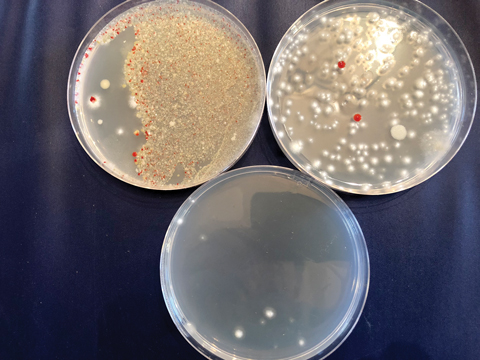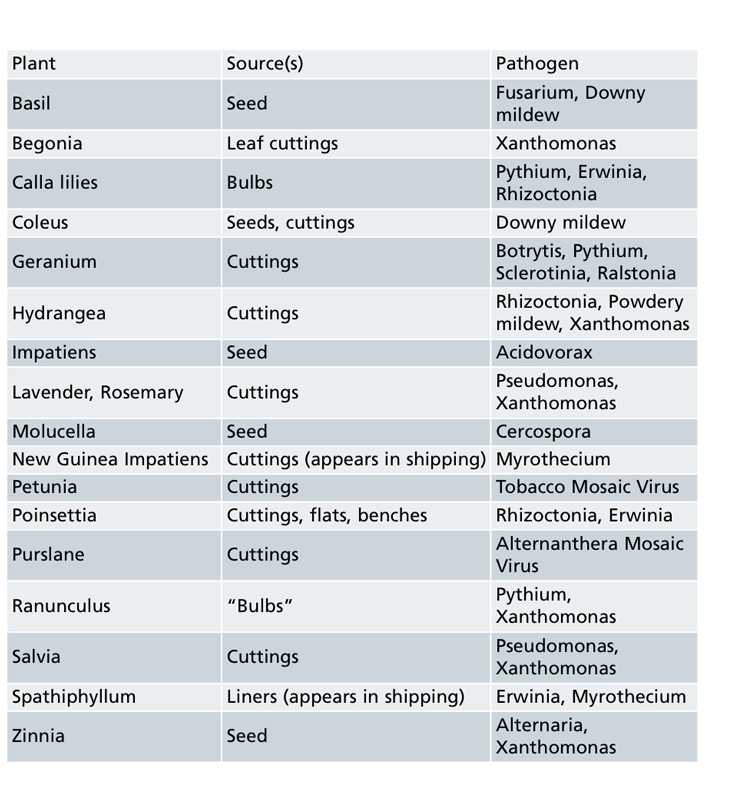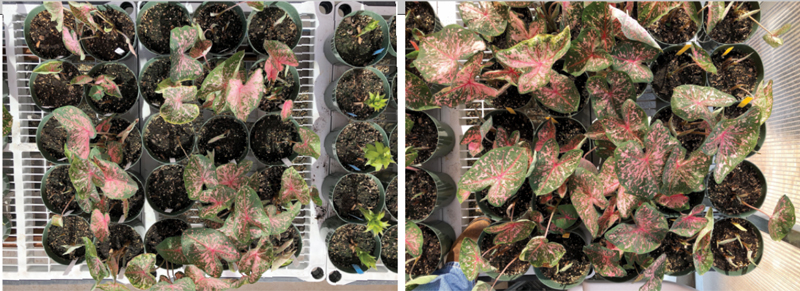12/1/2019
Avoiding Diseases in Propagation
Ann R. Chase

Diseases in propagation seem to go hand in hand at times. The characteristics of propagation that promote many diseases are excess water, high humidity, poor air movement and handling. In addition, there are generally open wounds on URCs for obvious reasons. This allows pathogens that need wounds for infection. Even if you have an ambitious “preventative” spray program—water trumps fungicides! That means poor water management cannot be repaired by application of fungicides and
bactericides.
Figure 1. Fungal and bacterial growth in dip water: Water only (top, left), DDAC 1 ml/liter (top, right) and DDAC 2 ml/liter (bottom, middle).
I’ve heard really good growers say that some diseases never occur unless the water isn’t managed correctly. That can mean turning the mat off overnight, shortening run times while increasing frequency and overall getting plants out of misting ASAP. Other successful actions include using under-bench heating in the winter to speed up rooting, using fans to move stagnant air around and, of course, careful monitoring for signs of rooting and/or signs of disease.
Shipping issues
In addition, you can save a lot of headaches by combating shipping damage with rehydration under cool/cold conditions before sticking. In addition, ethylene monitoring during shipping can alert you to possible problems that may only show up weeks after sticking, making the cause tough to identify.
One California foliage plant grower kept Erwinia from being a problem on spathiphyllum liners by letting them “cure” or harden-off for a few days before transplanting them after shipping. This kept the Erwinia that was present from taking over a stressed plant.
Contaminated seeds and cuttings
Unfortunately, pathogens on cuttings and seeds are more common than I would like. The fact that our propagators are often international makes the possibility of introducing a “new” disease more likely than in previous decades. There do appear to be fewer seed-borne diseases than 20 to 30 years ago, but I would watch out for “heirloom” varieties, especially on vegetables. These special crops aren’t usually handled the same way as the more common, newer varieties. This can be due to organic labeling or even relative sensitivity to this rare seed.
Recognize problems
It’s critical that you learn to recognize common diseases, or at least when something is wrong with your cuttings. Some fungi and bacteria are on cuttings or seeds—downy mildew, bacteria, Sclerotinia and even Pythium (Table 1). The table alludes to cases where I was sure that the pathogen was on the materials—all from unopened bags. Careful examination of URCs when received is critical. This will allow you to do something therapeutic to stop losses/damage. It’s also important to track the exact source and how they root out, etc. for each set of URCs. If you don’t, you cannot determine which source is most reliable.

Bactericide/fungicide treatments
Keep track of all fungicide/bactericide treatments you do, including dates and rates. It never helps to guess what worked or didn’t work after the crop is done. If you think a fungicide dip will cure all of your disease issues, I suggest you reconsider. Dipping isn’t the best idea for many herbaceous unrooted cuttings, as it can cause water-soaking and cutting loss.
Table 1. Some pathogens found on cuttings or seeds of horticultural crops.
You also must choose the right products and apply them when the cuttings are stuck, not three to five days later when the entire greenhouse or bench is full. Delaying treatment for Botrytis means no control. Use a product that stays on the URCs—for Botrytis, we found that Daconil WeatherStik was most effective under propagation conditions due to its capacity for “weathering” wet conditions. Just make sure to avoid getting any fungicide with chlorothalonil into the root area, as it can damage roots.
Do not use fungicides preventatively on everything—a few other products have been found to delay and even stop rooting on some crops. These include products with fludioxonil or triflumizole. It’s also common to see copper used under conditions where it won’t dry quickly (like propagation). The end result is sometimes phytotoxicity that may not be apparent to the naked eye. If you wound a plug or URC, that gives Botrytis an entry point and can lead you to believe that your Botrytis is resistant to copper. It’s not clear that this has happened since copper isn’t the best control for Botrytis and can cause phytotoxicity as mentioned above.
Speeding up propagation cycles
One key approach is to make sure that URCs get out of the propagation area as quickly as possible. Some products even help seeds germinate and URCs root. Strobilurins are a good example of this. A single spray with Pageant Intrinsic (4 oz./100 gal.) or RootShield Plus (4 oz./100 gal.) has improved germination and growth of ranunculus seed, rooting of solidago cuttings and rooting of myrtle cuttings. We’ve also seen Pageant Intrinsic help with drought stress on a commercial level. Similar benefits in rooting on poinsettias (and other crops) using fungicides with azoxystrobin (Heritage or Mural) has been demonstrated.

Dipping bulbs and URCs
Most recently, we’ve seen benefits in doing a bulb dip employing DDAC (KleenGrow). The product has been shown to reduce losses due to Fusarium on infected bulbs (tulip and daffodil). Our trials started by checking out the possibility that the dip solution might become contaminated with plant pathogens and end up spreading disease. We found that treatment with either 1 or 2 ml/liter actually killed bacteria and fungi in the dip water, making disease spread unlikely (Figure 1).
Figure 2. Caladium plants on the left (water dip) and caladium plants on the right (DDAC dip at 1 ml/liter for five minutes).
We also saw improved growth after a five-minute soak in 1 ml/liter for several bulb crops. This was probably due to improved wetting of the bulbs, as DDAC is a good wetting agent. These trials included calla lilies (three cultivars), caladiums, tulips, Asiatic lily, hyacinth and gladiolus. Figure 2 shows the caladium with greatly improved growth compared to water dip alone. We also saw improved rooting on hydrangea cuttings in one trial when the bundled cuttings were dipped into 1 ml/l DDAC for 30 seconds. We haven’t seen any damage from this treatment on URCs of hydrangea, rose, oleander, euonymus, loropetalum and raphiolepis.
Conclusions
We’re continuing our work on dipping bulbs to determine how long a dip solution is effective, as well as other products that are shown to promote rooting on some crops (OnGard from BioWorks) and additional work on DDAC on unrooted foliage plant and other herbaceous cuttings to better determine possible benefits in rooting.
* Don’t use contaminated seeds or cuttings
* Get an accurate diagnosis of problems that you don’t recognize
* Do not try to “cure” trash
* Be careful about using fungicides or certain water treatments on URCs
* DO NOT use recycled water in propagation at all!
* Manage your water—timing and amount
* Get plants out of propagation ASAP
* Use RootShield Plus or a strobilurin like Heritage, Mural or Pageant Intrinsic to shorten propagation cycles GT
Ann R. Chase is a plant pathologist and president of Chase Agricultural Consulting, LLC in Cottonwood, Arizona.